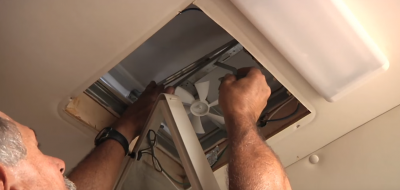Things you can do to make your visit to the service shop less stressful
and enable your down-time to be as brief as possible.
Has this ever happened to you? Maybe not this specific problem, but this scenario in general. You’re on the third day of that much anticipated and much needed vacation trip when, out of the blue, while stopped for breakfast, you realize your generator will not start. No problem, you say, there’s an RV repair shop just two miles back.In Part I of this three part series, let’s extrapolate and explore the above scenario a little deeper:
So you decide to return to that service center. As you pull into the service drive, another coach pulls in behind you. You explain your problem to the service writer, sign the repair order, proceed to the customer waiting area, (aptly named), grab a cup of coffee and wait. And wait, and wait and wait. Then after that, you wait still longer.
As you audibly, (it seems), hear your vacation clock ticking away, you finally come to realize the coach that had pulled in behind you is long gone as are all the rigs that pulled in behind him. You catch a quick reflection of yourself as you pass by the glass-walled service office and wonder when you grew that beard. And just who is that older woman with you anyway? You glance out and see your generator in, what appears to be, hundreds of pieces scattered around the service bay. You swallow hard and shudder. Finally, at about closing time, the service manager informs you your coach is ready. “Funny,” he says, “It was just a loose wire behind the dash switch.”
After six hours of pacing and daydreaming about that large bass calling your name while you grow old in a customer waiting lounge, all the technician found wrong was a loose wire? Is that it? Why did it take so long? C’mon, a loose wire? He had the generator completely disassembled! Your frustration level grows even more when you find out that the coach that had pulled in behind you had a much more difficult and more technical problem, and he’s been back on the road for over four hours. What gave him the edge? Why was it that his “harder-to-find” problem was diagnosed and repaired in a third less time than your relatively simple problem? And why is this guy charging you $440 to tighten a loose wire?
Just maybe that previous customer provided a little insight and direction for the service writer and technician. Quite possibly he supplied enough clues to enable the repair shop to pare minutes, if not hours, off the troubleshooting time and unless this is your first exposure to RVing, you know that within the realm of RV repair facilities, time equates to dollars, especially for those non-warranty, or customer-pay invoices. It stands to reason then, if there is anything you can do to help speed up the diagnostic and repair time, you, the coach owner, will save in the long run.
But what can you do? Certainly you cannot be called upon to perform highly technical, diagnostic procedures on every component on your RV. No, most professional service technicians even have a hard time with that. What follows, however, is the first of five items that you can do that will not only benefit you and your recreational investment, but it just might provide enough of a road map or direction for the service shop to follow when performing troubleshooting procedures. At a minimum, it will help eliminate areas that need not be looked into during the diagnostic tasks.
1. Record All Identifying Numbers
Here’s a tip that is highly recommended whether you choose to follow the advice in this article or not. This step alone will help you to at least create a biographical sketch of your coach. It will be beneficial to you and any subsequent owner of your unit. By keeping, somewhere in the literature for your RV, a list of all brand names, models numbers, serial numbers and any spec numbers for all components that have such numbers, your dealer or service center will be able to rapidly transfer the necessary numbers to the repair order rather than go to the individual component to retrieve them; some may be located in hard to reach places. Additionally, the service writer will be able to identify those appliances or devices that may be under a subject recall, regardless of the reason for your current visit. Or should you be required to contact the customer service representative of any product component, this reference list will come in handy.
What follows is a sample format you may want to use for this purpose. Remember, not every example of a component part that may have a model number is listed here. This is simply to give you an idea to follow for your own chart. You may need to add or delete many items in order to reflect the actual components found on your coach.

Okay, chew on this first idea for awhile. Next week we’ll delve into a couple more ways you can assist your RV service shop.
Gary Bunzer, The RV Doctor





blogiew
Привет, я думала что это совсем не так происходит:)
——————————————-
Мой блог: http://vyazaniegalereya.blog.ru/
Bill Mac Queen
I have purchased a 1988ROCKWOOD XL and it has low milage but the oil pressure to me is very low.It is a 460 ford and was wondering if anyone is having the same guestion.Thanks Bill PS does anyone have the manual for this chassis
Pingback: 5 Ways to Assist the RV Service Facility - Part 3
Pingback: 5 Ways to Assist the RV Service Facility - Part 2
William Andersen
My motor home was about one year old when I bought it from the original owner: he gave me all of the documents and manuals that came with the motor home.
I entered the Model Numbers and Serial Number on the cover page of each manual and highlighted the Model Number in the manual wherever there was model specific information. This helped me become familiar with the equipment in the motor home, and helps me find answrs to questions when I review the manuals.
I also keep a list of all service and repairs, with the milage and date so I can easily determine when it’s time for an oil change, how old the tires are, etc.